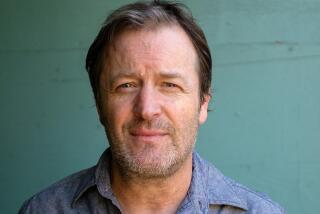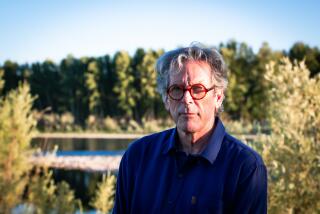A sweeping, intricate journey west
- Share via
“The Last Crossing” is a terrific novel, big, complex, gripping.
Its author, Guy Vanderhaeghe, who lives in Saskatchewan and has published six previous novels and two plays, has a large following in Canada. He deserves one in the States.
His subject sweeps in time from the middle of the 19th century into the early 20th and stretches in space from Victorian England and the U.S. Civil War through the American West into the Canadian West, where its heart is.
In that sense, “The Last Crossing” is a historical novel that covers another era. But the opprobrium that some attach to the phrase “historical novel” should not apply here. True, the book vividly evokes a past long gone and perhaps only dimly remembered. But there is no musty scent to it, no intimation of all-too-visible reconstruction. The people in it could be contemporaries of ours, though they speak in varieties of English that sound subtly appropriate for their origins and time.
His half-dozen or so major characters and many minor ones are palpably alive and present to the reader. Its plot -- and there is an intricate and thoroughly satisfying one -- is deft and put together seamlessly.
These are the bones of the story: One of the three sons of a rich and rigid Englishman leaves the family’s fine country home and London dwelling and disappears into the western wilds of North America. In 1871 his twin brother and their older brother go in search of him.
The eldest, who in the army was involved in a very messy business of subduing protesters in Ireland, is both a romantic and -- despite the Irish dreams that haunt him -- a bit of an over-achieving Boy Scout. The younger brother, a painter, is wiser and more cautious.
They make their way to Fort Benton on the Missouri River, in what is now Montana. Here they meet the various souls who will go with them north to British territory, where the plains rise to meet the towering Rockies.
Among their companions is an intrepid woman who has a couple of searches of her own on her mind, an American newspaperman to whom Vanderhaeghe hilariously gives the kind of pompous inflated talk that infested the more pretentious newspapers of the 19th century and another man who is what used to be contemptuously called a half-breed -- the son of a Scottish father and an Indian mother.
He is Jerry Potts, the only historical character in the novel, and as Vanderhaeghe slowly but steadily fills out his portrait, he turns out to be one of the most important. When we meet him he is a skillful but taciturn mountain man; by his death he has become, as he did historically, a great builder of the Canadian West and a conciliator between inflowing settlers and the bewildered Indians.
Vanderhaeghe’s sure-footed tale comes to rest, in the end, on three pillars: Potts, the artist son Charles Gaunt and the remarkable woman Lucy Stoveall. Though intrepid is the unavoidable description of this person in the raw and masculine West, she is as far from the stereotype heroine of Western novels and movies as it is possible to be. In Vanderhaeghe’s deft hands she becomes, gradually, the character with the finest and most subtle moral sensibility.
It says much for Vanderhaeghe’s skill as a writer that you cannot guess, as the book gets underway, the turns his characters and plot will take. Aspects you think are foretold are not; developments in both psychology and action take you pleasantly by surprise.
No cliches lurk in his easy-flowing prose, which catches the look and feel of the North American West with arresting precision and displays it freshly, as if no one had described it before.
His Indians, and there are many -- Blackfeet, Crow, Cree -- are treated with both respect and refreshing straightforwardness. His other characters ring as true as their roles permit.
Vanderhaeghe re-creates a time when the new inhabitants of the continent were exploding westward and engulfing those who were already here. It was a time of violence, ambition, greed and shame, yet tempered by the human desire for stability, honor and love. It is not too much to call Vanderhaeghe’s vast canvas magnificent.
More to Read
Sign up for our Book Club newsletter
Get the latest news, events and more from the Los Angeles Times Book Club, and help us get L.A. reading and talking.
You may occasionally receive promotional content from the Los Angeles Times.










